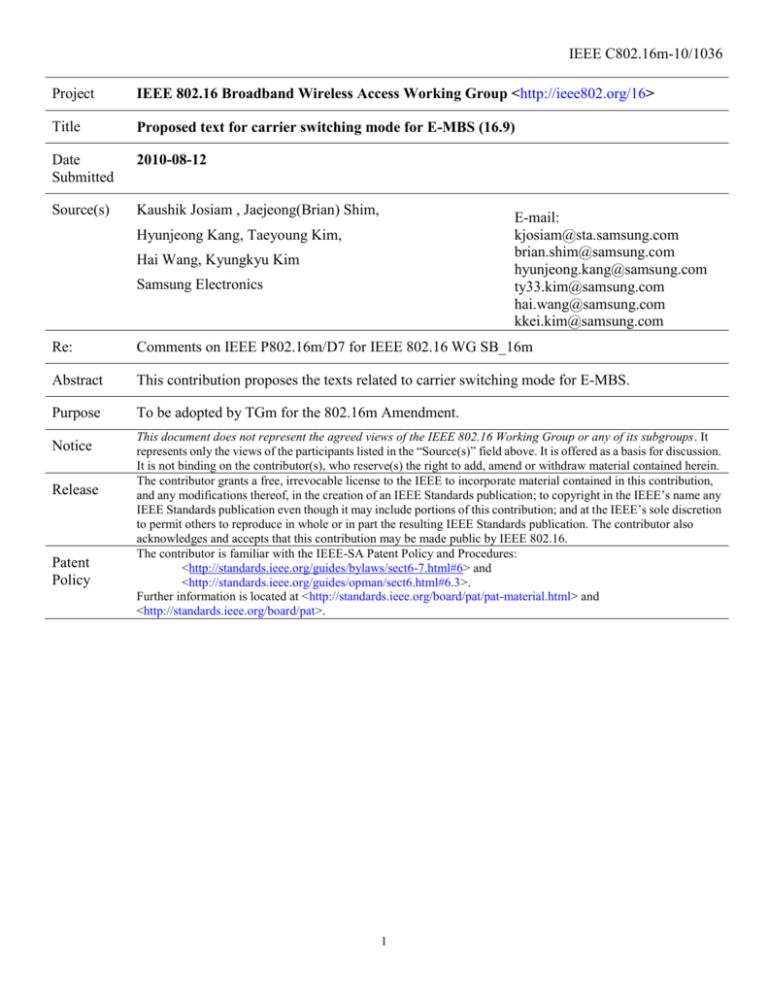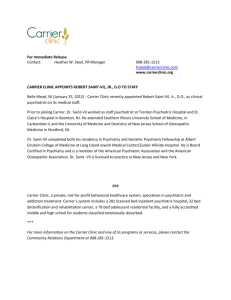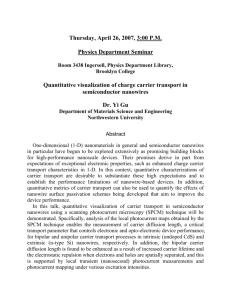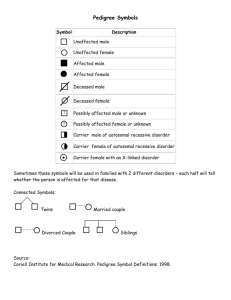Project
advertisement

IEEE C802.16m-10/1036 Project IEEE 802.16 Broadband Wireless Access Working Group <http://ieee802.org/16> Title Proposed text for carrier switching mode for E-MBS (16.9) Date Submitted 2010-08-12 Source(s) Kaushik Josiam , Jaejeong(Brian) Shim, E-mail: kjosiam@sta.samsung.com brian.shim@samsung.com hyunjeong.kang@samsung.com ty33.kim@samsung.com hai.wang@samsung.com kkei.kim@samsung.com Hyunjeong Kang, Taeyoung Kim, Hai Wang, Kyungkyu Kim Samsung Electronics Re: Comments on IEEE P802.16m/D7 for IEEE 802.16 WG SB_16m Abstract This contribution proposes the texts related to carrier switching mode for E-MBS. Purpose To be adopted by TGm for the 802.16m Amendment. Notice Release Patent Policy This document does not represent the agreed views of the IEEE 802.16 Working Group or any of its subgroups. It represents only the views of the participants listed in the “Source(s)” field above. It is offered as a basis for discussion. It is not binding on the contributor(s), who reserve(s) the right to add, amend or withdraw material contained herein. The contributor grants a free, irrevocable license to the IEEE to incorporate material contained in this contribution, and any modifications thereof, in the creation of an IEEE Standards publication; to copyright in the IEEE’s name any IEEE Standards publication even though it may include portions of this contribution; and at the IEEE’s sole discretion to permit others to reproduce in whole or in part the resulting IEEE Standards publication. The contributor also acknowledges and accepts that this contribution may be made public by IEEE 802.16. The contributor is familiar with the IEEE-SA Patent Policy and Procedures: <http://standards.ieee.org/guides/bylaws/sect6-7.html#6> and <http://standards.ieee.org/guides/opman/sect6.html#6.3>. Further information is located at <http://standards.ieee.org/board/pat/pat-material.html> and <http://standards.ieee.org/board/pat>. 1 IEEE C802.16m-10/1036 Proposed text for carrier switching mode for E-MBS (16.9) Jaejeong(Brian) Shim, Kaushik Josiam, Taeyoung Kim, Hai Wang, Kyungkyu Kim, Hyunjeong Kang Samsung Electronics 1. Introduction According to P802.16m/D7 [1], E-MBS service may be provided at alternative carrier for E-MBS transmission rather than primary carrier. In the case, E-MBS-MAP and data bursts are sent from the alternative carrier and AMS with only one transceiver should perform carrier switching to alternative carrier for E-MBS. To switch carriers, AMS uses connection and service information from Primary Carrier (i.e., MSTIDs+FIDs, PHY carrier index etc.) via DSx Procedure. Generally, a group of default E-MBS contents are initiated at the same time with the AAI_DSA message to reduce the E-MBS contents switching delay within the default E-MBS contents. This is why we have group parameters in AAI_DSx messages. Recent contributions proposed a reporting mechanism in which AMS notifies the specific E-MBS contents it is receiving/watching, i.e., activated E-MBS contents, using new MAC management messages on the primary carrier. This allows unicast data transmission on the primary carrier whenever the AMS is available at the primary carrier. However, the reporting mechanism has burden of message overhead & carrier switching in each E-MBS contents change. While reporting may be necessary, we believe that it should be the last fall back option in case no other approach to accommodate carrier switching works. 2. Proposal If multicarrier feature is supported by the AMS and the ABS, the ABS should use AAI_DSA-REQ/RSP message to redirect the AMS to AAI E-MBS zone of other carriers, if such redirection is needed. During the DSA transaction, the ABS allocates unicast available interval using a Unicast Available Interval Bitmap to the AMS. As shown in Figure 1, the AMS shall go back and forth between the primary carrier and secondary carrier using the Unicast Available Interval Bitmap. The unicast available interval bitmap is a string of N bits b0,b1,b2,…,bN where bi can take on a value of 0 or 1 and i indicates the position of the bit in the string. The value of N depends on the MSI. Each bit bi corresponds to a time interval in the MBS scheduling interval (MSI). An MSI is split into N intervals with each interval represented by a bit. When the ith bit bi takes on value 0, then the AMS is unavailable to the primary carrier for unicast scheduling and is in the secondary carrier receiving E-MBS; if the ith bit bi takes on value 1, then the AMS is available to the primary carrier for unicast 2 IEEE C802.16m-10/1036 scheduling. Carrier switching from the secondary E-MBS carrier to the primary carrier occurs at the end of interval i when bibi+1 ==01 i.e., when the bits in the string at the ith and i+1th position are 0 and 1 respectively. Similarly, the AMS switches carrier from the primary carrier to the secondary E-MBS carrier occurs at the end of interval i when bibi+1 ==10 i.e., when the bits in the string at the ith and i+1th position are 1 and 0 respectively. Whenever the AMS adds/removes E-MBS content, the ABS shall re-allocate the Unicast Available Interval and update the Unicast Available Interval Bitmap. MSI Primary carrier Carrier Switching Carrier Switching AMS selects E-MBS CH-2 Carrier Switching Superframe Control/ Unicast Secondary carrier CH-1 CH-2 CH-3 Available Interval 0 CH-4 CH-5 Available Interval 1 EMBS Available Interval CH-6 CH-7 EMBS Data CH-8 Available Interval 2 Available Interval 3 Unicast Available Interval Unicast Available Interval Bitmap 0 1 1 1 Available Interval Bitmap 0 1 1 1 E-MBS channels which AMS can watch E-MBS MAP AAI_E-MBS-CFG message Figure 1 – An example of the Carrier Switching Modes based on either Unicast Availabe Interval Bitmap or Available Interval Bitmap report. In some cases, the ABS may not be able to allocate an explicit unicast available interval in the AAI_DSA –REQ/RSP message. Such cases can occur if the streams for which the DSA transactions are carried out, occupy most of the MSI. When the AAI_DSA enables streams that are scheduled in the secondary carrier for a significant portion of the MSI, then a unicast available interval cannot be clearly identified for the AMS. When a unicast available interval is not identified, the AMS at a disadvantage of not being able to be scheduled for any unicast data. To overcome such scenarios, we allow the AMS to indicate its Available Interval of interest during which it is available in the primary carrier to receive unicast data. To enable such reporting, the AAI_DSA transactions will set Carrier Switching Mode in AAI_DSA-REQ 3 IEEE C802.16m-10/1036 /RSP to 0b1 This setting will allow the AMS to switch to the secondary carrier so that it may receive the E-MBS MAP and switch back to the primary carrier. On receiving the E-MBS MAP, it will report to the ABS, the discrete interval when it plans to switch to the secondary carrier to receive E-MBS data using an Available Interval Bitmap whose structure and operation are similar to the Unicast Available Interval Bitmap sent in the AAI _DSA-REQ/RSP message. To compute the interval, the AMS assumes that the MSI is divided into four equal available intervals. Each interval is computed in the interval of frames. Using a predefined MAC management message, called AAI_E-MBS-REP message, the AMS indicates to the ABS which interval it will be available in the primary carrier for unicast scheduling. An illustration of the available interval based availability reporting is shown in Figure 1. 3. References [1] IEEE P802.16m/D7, “DRAFT Amendment to IEEE Standard for Local and metropolitan area networks” 4 IEEE C802.16m-10/1036 4. Text proposal for the 802.16m DRAFT amendment Note: The text in BLACK color: the existing text in the 802.16m Amendment Draft Standard The text in RED color: the removal of existing 802.16m Amendment Draft Standard Text The text in BLUE color: the new text added to the 802.16m Amendment Draft Standard Text -----------------------------------Start of the Proposed Text -------------------------------------[Remedy #1: Adopt the following changes in Section “16.9.2.3 E-MBS Operation on the multi-carrier deployment”, pp 870:] 16.9.2.3 E-MBS Operation on the multi-carrier deployment When E-MBS data, including E-MBS configuration message, E-MBS MAP, and E-MBS contents, is transmitted on an alternative carrier, i.e. other than the AMS’s primary carrier where service flows are configured, the AMS is redirected to the relevant carrier carrying E-MBS data through DSA as described in 16.9.2.1. The AMS with multiple transceivers may be able to receive E-MBS data while communicating with ABS on primary carrier. The AMS with only one transceiver may perform primary to secondary carrier switching where E-MBS configuration message and the E-MBS data are transmitted on an alternative carrier to the AMS and other communication with ABS is performed in the primary carrier. A Carrier Switching Mode is included in AAI_DSA-REQ/RSP message for selecting carrier switching mode. If Carrier Switching Mode is 0b0, the carrier switching based on Unicast Available Interval is applied. If Carrier Switching Mode is 0b1, the carrier switching based on Available Interval Report by AMS is applied. A Carrier Switching Start Time is included in AAI_DSA-REQ/RSP message for Carrier Switching Mode 0b0 or 0b1 to indicate the time the AMS performs carrier switching to the secondary carrier. When Carrier Switching Mode is 0b0, Unicast Available Interval Bitmap is included in AAI_DSA-REQ/RSP message for carrier switching mode to indicate the duration in which the AMS is available in the primary carrier for Unicast and duration the AMS is in the secondary carrier to receive E-MBS. The unicast available interval bitmap is a string of N bits b0,b1,b2,…,bN where bi can take on a value of 0 or 1 and i indicates the position of the bit in the string. The value of N depends on the MSI. Each bit bi corresponds to a time interval in the MBS scheduling interval (MSI). An MSI is split into N intervals with each interval represented by a bit. When the ith bit bi takes on value 0, then the AMS is unavailable to the primary carrier for unicast scheduling and is in the 5 IEEE C802.16m-10/1036 secondary carrier receiving E-MBS; if the ith bit bi takes on value 1, then the AMS is available to the primary carrier for unicast scheduling. Carrier switching from the secondary E-MBS carrier to the primary carrier occurs at the end of interval i when bibi+1 ==01 i.e., when the bits in the string at the ith and i+1th position are 0 and 1 respectively. Similarly, the AMS switches carrier from the primary carrier to the secondary E-MBS carrier occurs at the end of interval i when bibi+1 ==10 i.e., when the bits in the string at the ith and i+1th position are 1 and 0 respectively. Whenever the AMS adds/removes E-MBS content, the AMS shall discontinue carrier switching, return to the primary carrier and the ABS shall re-allocate the Unicast Available Interval and update the Unicast Available Interval Bitmap using a new AAI-DSA transaction. When Carrier Switching Mode is 0b1, the AMS initially switches to the secondary E-MBS carrier to decode both the AAI_E-MBS_CFG message and the E-MBS MAP. The AMS acquires the resource allocation information for all E-MBS contents, so the AMS knows the available interval where the E-MBS content selected by AMS is included. After acquiring this information, the AMS performs secondary to primary carrier switching for transmitting AAI_E-MBS-REP message. An Available Interval Bitmap is included in AAI_E-MBS-REP message, defined in Section 16.2.3.x to inform the ABS of the Available Interval(s) including E-MBS content selected by AMS in the secondary carrier using 4 bits b0b1b2b3. If bi is equal to 1, then AMS is available to the primary carrier for unicast scheduling during the ith Available Interval. When E-MBS_CFG_LIFETIME in the AAI_E-MBS-CFG message expires, the AMS shall perform primary to secondary carrier switching before the beginning of the superframe that carries AAI_E-MBS_CFG message in order to decode the AAI_E-MBS_CFG message. Otherwise, the AMS shall keep the current carrier switching rule as defined by the bitmap. The AMS shall stay on the secondary carrier or perform primary to secondary carrier switching to decode the E-MBS MAP, regardless of Unicast Available Interval Bitmap or Available Interval Bitmap and switch after the E-MBS MAP is decoded. If S-SFH is changed on the primary carrier, the AMS shall stay on the primary carrier to stop the carrier switching. If S-SFH is changed on the secondary carrier, the AMS shall perform the secondary to primary carrier switching to stop the carrier switching. [Remedy #2: Adopt the following changes in Section “16.2.3.46.1 AAI_DSA-REQ”, line#49, pp 188] 16.2.3.46.1 AAI_DSA-REQ …. - E-MBS Service: Indicates whether the MBS service is being requested or provided for the connection that is being setup. - E-MBS Zone ID: Indicates an E-MBS zone where the connection for associated service flow is valid. - E-MBS Service Flow Parameter: Mapping of E-MBS ID and FID are included. - Physical Carrier Index: Target carrier which the AMS switches or is redirected by ABS to, only included in ABS initiated DSA-REQ. 6 IEEE C802.16m-10/1036 - Carrier Switching Mode: Indicates the carrier switching mode based on between unicast available interval and available interval report - Carrier Switching Start Time: 4 LSBs of superframe number at which carrier switching happens - Unicast Available Interval Bitmap: Indicates when the AMS should be available in the primary carrier After a successful DSA/DSC transaction, BR index mappings included in the AAI_DSA-REQ or AAI_DSC-REQ messages shall override previously defined BR index mappings for the same BR indices. The FID for the transport connection shall not be present in the AMS-initiated AAI_DSA message; at the ABS, the service flow within the AAI_DSA-REQ message shall be assigned a unique FID for the transport connection, which will be sent back in the AAI_DSA-RSP message. AMS-initiated AAI_DSA-REQ messages may use the service class name in place of some, or all, of the QoS parameters. ABS-initiated AAI_DSA-REQ messages for named service classes shall include the QoS parameter set associated with that service class. ABS-initiated AAI_DSA-REQ messages shall also include the Target SAID for the service flow. Table 740 –AAI_DSA-REQ M/O Attributes/Array of attributes Size (bits) Value/Notes Conditions … … … … … O Carrier Switching Mode 1 0b0: carrier switching based on Unicast Available Interval 0b1: carrier switching based on Available Interval report In case of ABS-initiated DSA for carrier switching O Carrier Switching Start Time 4 4 LSBs of superframe number at which carrier switching happens In case of ABS-initiated DSA for carrier switching O Unicast Available Interval Bitmap Indicates when the AMS should be available in the primary carrier using N bits b0b1b2 …bN-1 If bi == 0, then AMS is available for E-MBS data scheduling in secondary carrier If bi==1, then AMS is available for unicast scheduling in primary carrier In case of ABS-initiated DSA for carrier switching Variab le NMSI = 2 superframes: N = 4 bits NMSI = 4 superframes: N = 4 bits 7 Shall be present if Carrier Switching Mode=0b0 IEEE C802.16m-10/1036 NMSI = 8 superframes: N = 8 bits NMSI = 16 superframes: N = 16 bits Depending on the NMSI, the number of bits per subframe changes If NMSI = 2, then 2 frames per bit If NMSI = 4, 8 and 16, then 4 frames per bit [Remedy #3: Adopt the following changes in Section “16.2.3.46.2 AAI_DSA-RSP”, line# 51, pp 200] 16.2.3.46.2 AAI_DSA-RSP …. - E-MBS Service: Indicates whether the MBS service is being requested or provided for the connection that is being setup. - E-MBS Zone ID: Indicates an E-MBS zone where the connection for associated service flow is valid. - E-MBS Service Flow Parameter: Mapping of E-MBS ID and FID are included. - Physical Carrier Index: Target carrier which the AMS switches or is redirected by ABS to. - Carrier Switching Mode: Indicates the carrier switching mode based on between unicast available interval and available interval report - Carrier Switching Start Time: 4 LSBs of superframe number at which carrier switching happens - Unicast Available Interval Bitmap: Indicates when the AMS should be available in the primary carrier Table 741 –AAI_DSA-RSP M/O Attributes/Array of attributes Size (bits) Value/Notes Conditions … … … … … O Carrier Switching Mode 1 0b0: carrier switching based on Unicast Available Interval 0b1: carrier switching based on Available Interval report Present if ABS indicates carrier switching when receiving 8 IEEE C802.16m-10/1036 AMS-initiated DSA O Carrier Switching Start Time 4 O Unicast Available Interval Bitmap Variab le 4 LSBs of superframe number at which carrier switching happens Present if ABS indicates carrier switching when receiving AMS-initiated DSA Indicates when the AMS should be available in the primary carrier using N bits b0b1b2 …bN-1 If bi == 0, then AMS is available for E-MBS data scheduling in secondary carrier If bi==1, then AMS is available for unicast scheduling in primary carrier Present if ABS indicates carrier switching when receiving AMS-initiated DSA NMSI = 2 superframes: N = 4 bits NMSI = 4 superframes: N = 4 bits NMSI = 8 superframes: N = 8 bits NMSI = 16 superframes: N = 16 bits Shall present if Carrier Switching Mode=0b0 Depending on the NMSI, the number of bits per subframe changes If NMSI = 2, then 2 frames per bit If NMSI = 4, 8 and 16, then 4 frames per bit [Remedy #4: Insert the following section, line# 65, pp 227] 16.2.3.x AAI_E-MBS-REP An AMS should use AAI_E-MBS-REP message to inform ABS that is the primary carrier, of the interval during which it is available for unicast scheduling. This interval indication is carried in the available interval bitmap. The AAI_E-MBS-REP message also carries E-MBS Zone ID of the E-MBS Zone from which the AMS is currently receiving E-MBS data and is transmitted when Carrier Switching Mode=0b1 in AAI_DSA-REQ/RSP message. Table xxx –AAI_E-MBS-REP message 9 IEEE C802.16m-10/1036 M/O Attributes/Array of attributes Size (bits) Value/Notes Conditions M MAC Control Message Type 8 AAI_E-MBS-REP message It will be present when Carrier Switching Mode=0b1 in AAI_DSA-RE Q/RSP. M E-MBS Zone ID 7 Indicates E-MBS Zone from which the AMS is currently receiving E-MBS data It will be present when Carrier Switching Mode=0b1 in AAI_DSA-RE Q/RSP. M Available Interval Bitmap 4 Indicates Available Interval where the E-MBS channel selected by AMS is included in the secondary carrier using 4 bits b0b1b2b3 It will be present when Carrier Switching Mode=0b1 in AAI_DSA-RE Q/RSP. If bi==0, then AMS is available for E-MBS data scheduling in secondary carrier If bi==1, then AMS is available for unicast scheduling in primary carrier If NMSI = 2, then 2 frames per bit If NMSI = 4, then 4 frames per bit If NMSI = 8, then 8 frames per bit If NMSI = 16, then 16 frames per bit -------------------------------------End of the Proposed Text 10 --------------------------------------------------------







